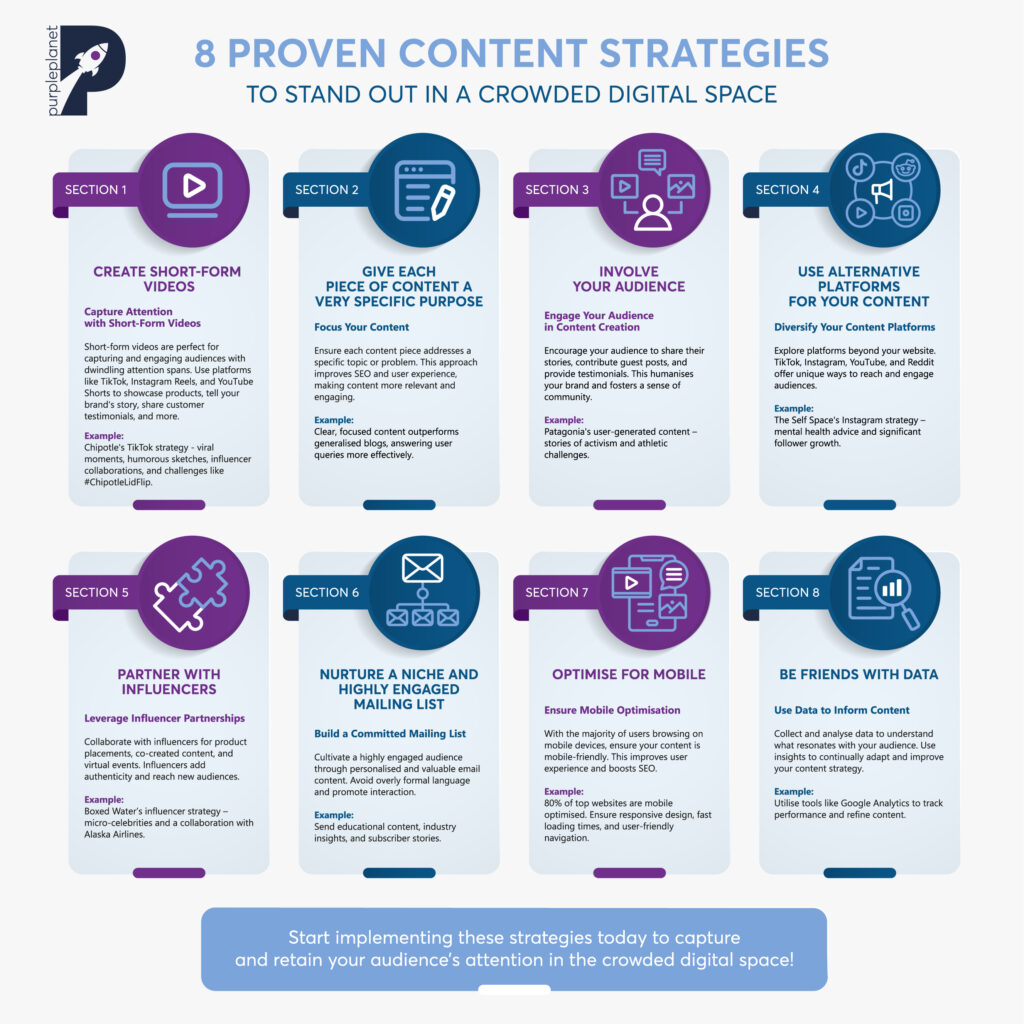

8 Content Strategies to Capture Attention in a Crowded Digital Space
Key takeaways
-
To engage audiences with content, brands must be succinct and specific, and avoid being too salesy.
-
The world of SEO content is changing, and brands might be better off nurturing a small but highly engaged mailing list of subscribers.
-
Successful brands are telling the stories of everyday people and sharing user-generated content.
What’s happening in the world of content right now?
For years the world of SEO content has been exciting and novel, and there is a lot of information online about optimising blogs so that businesses can rank as highly as possible on Google.
But currently, the realm of content creation is challenging. With each algorithm update, businesses are finding it harder to rank well on Google and search engine users are complaining about ‘over-optimised’ results. The problem is, things like SEO, affiliate marketing, and AI-generated content are muddying the waters.
Legitimate sources of content are being outranked by other low-quality sites with good SEO. And despite Google’s constant efforts, it’s very difficult for users to find the content they’re looking for. Search terms are hijacked by blogs that, though are in the relevant field, aren’t actually answering user queries.
This state of affairs is leading to several changes in user behaviour:
- Users are getting frustrated by overly optimised results, feeling that they are not genuine anymore.
- Searchers are looking to TikTok and YouTube for succinct results as these offer quick answers that aren’t trying to sell them anything.
- Users are writing “reddit” at the end of their search queries because this will show user-generated advice and insights from real people.
- Users are going straight to AI models for specific answers (e.g., ChatGPT and CharacterAI).
- People are using AI search engines like Arc Search – which generates the user a completely unique webpage by collating real pages and removing the waffle.
Taking a quick look at this Reddit thread will tell you everything you need to know about users’ frustrations with content on Google at the moment. Evidently, the landscape has changed significantly.
So, what can you do about it?
Well, the good news is that users still want quality content – they haven’t sworn it off completely. It may be that in the future SEO-type content ceases to be a source of lead generation entirely, but we’re not there yet.
It’s likely that off-page ranking factors will become more important (e.g., backlinks). So, if you’re worried about your website’s SEO this could be a mitigating strategy for you.
In terms of content creation, there are lots of things you can do to remain relevant, useful, and accessible for users. Let’s dive into some of our top ideas:

1. Create short-form videos
With the average user attention span dwindling, short-form video content stands as a highly effective strategy for capturing and engaging audiences. Platforms like TikTok, Instagram Reels, and YouTube Shorts are excellent for this type of content, as they have tools that make it easy for creators to produce their videos.
Short videos can be used for a wide range of purposes, from showcasing products/services, telling your brand’s story, sharing customer testimonials, revealing behind-the-scenes action, and simply comedic sketches.
This method is often more cost-effective compared to traditional digital marketing strategies like email marketing, which requires constant content creation and management, or influencer partnerships, which can involve high upfront costs.
Creating short-form videos can be significantly low on resources. Businesses can produce high-impact content with minimal investment by using simple, readily available video editing tools. This makes short-form video an exceptionally viable option for businesses aiming to expand their digital footprint efficiently.
If you want to choose this strategy, make sure you incorporate relevant keywords in the title, description, and tags. This will help audiences discover you and put you on the map.
A brilliant example of this is Chipotle’s TikTok strategy. The fast food chain had a viral moment on Vine 10 years ago and has seemingly embraced the short video form ever since. Posting humorous sketches consistently, the brand also collaborates with influencers and posts challenges. Most notably, the #ChipotleLidFlip challenge amassed millions of views and the brand boasts great success in reaching a younger audience since 2018.
2. Give each piece of content a very specific purpose
More than ever, it’s crucial that each piece of content you publish has a super specific purpose. This super-focused approach answers the problem current users are facing – they are sick of seeing generalised blogs that don’t answer their specific queries.
Since SEO began there’s been the problem of keyword stuffing, and this hasn’t entirely disappeared despite Google’s best efforts. This can take the form of simply cramming too much information into a single blog post, diluting the message and making it harder for users to understand its purpose.
When a post tries to address multiple topics or answer various questions, it often fails to satisfy any particular query thoroughly. This lack of focus can impair the content’s ability to rank well for specific keywords, as search engines strive to provide the most relevant and targeted answers to user queries.
Creating content with a specific purpose tackles this issue head-on. By focusing on a single topic or problem per piece, businesses can craft messages that are more coherent and impactful. This clarity not only improves SEO by aligning closely with specific search terms but also enhances the experience for users. Readers or viewers can quickly grasp the value of the content, which is crucial in capturing and maintaining their attention.
3. Involve your audience
A unique approach to content creation is involving your audience in the process.
Doing this might look like asking readers to share their own stories, contribute guest posts, take part in challenges, or provide testimonials about their experiences with your product/service. This approach doesn’t have to include content that explicitly promotes your brand – it could be a monthly feature of publishing the best article written by a subscriber.
For example, Patagonia – the activewear clothing brand – takes a huge interest in environmental issues. On its website, you can find lots of stories about activism and athletic challenges from everyday people. E.g., this short film about one man’s 24-hour run that raises awareness for air quality issues and this blog post by a Patagonia Ambassador/rock climber/ seamstress.
Getting customers and everyday people from your target audience to share their stories humanises your brand. It can be unexpected, upbeat, inspiring, and much more charming than traditional advertising. This type of content resonates with potential customers because it comes from peers they can relate to and isn’t the usual salesy-content they’re bored of.
In addition, this approach can create a sense of community. Cost-wise, this approach is pretty economical. Paid ads, in comparison, can be expensive and don’t guarantee engagement. We think user-generated content can be really powerful and, overall, enhances your authenticity as a brand.
4. Use alternative platforms for your content
As Google becomes increasingly cluttered with over-optimised content, businesses will need to explore alternative platforms for their content creation to maintain and grow their audience engagement.
If you want to move away from posting solely on your website’s blog, platforms like TikTok, Instagram, and YouTube are most exciting:
- TikTok, with its rapid-fire, highly engaging short-form video content, is particularly effective at capturing the attention of younger demographics. The platform’s algorithm favours novelty and engagement, offering businesses a chance to go viral with creative, original content that showcases their products or services in a fun and approachable way.
- Instagram continues to be a powerhouse for brands looking to visually showcase their offerings. With features like Stories, Reels, and IGTV, businesses have multiple formats to create narrative-driven content that resonates with a visually oriented audience.
- YouTube remains the leader in long-form video content, providing a space for more in-depth storytelling, product reviews, tutorials, and educational content. This platform allows businesses to build a comprehensive content library that can address detailed consumer queries and showcase your company’s expertise.
While Reddit might seem less straightforward for direct marketing due to its discussion-based nature, it can still be a valuable tool for gaining insights into consumer interests. Businesses can engage with Reddit from an investigative point of view, using it to search for topics of interest and gaps in customer knowledge.
Branching out to these platforms allows businesses to diversify their digital footprint, connect more effectively with different segments of their audience, and break free from the diminishing returns of over-optimised web content.
A great example of this is The Self Space, a London-based mental health service that began an Instagram strategy in 2019. Posting bite-sized mental health advice, the service now has 125,000 Instagram followers and boasts 84 therapists (they must be doing something right!).
5. Partner with influencers
While businesses fight on the Google battleground for good rankings, influencers seem to have it all. It’s becoming increasingly obvious that partnering up with influencers is one of the best ways to reach new audiences and boost brand authenticity.
Creative forms of influencer partnerships can vary widely, from traditional product placements and endorsements to more innovative approaches like co-created content, takeovers of brand social media accounts, or participation in brand challenges and campaigns.
Influencers can also host virtual events, create tutorials demonstrating how to use a product, or share personal stories about their experiences with a brand, adding a layer of personal testimony to the product’s benefits.
This strategy works because influencers have already earned the trust and loyalty of their followers. Their endorsements serve as powerful social proof, leveraging their credibility to sway purchasing decisions favourably towards the brand they represent.
Cost-wise, influencer marketing can be highly economical compared to traditional advertising. The return on investment can also be significant, as influencers often generate higher engagement rates. Don’t forget, costs can always be controlled and scaled based on the influencer’s reach and the terms of partnership, allowing even smaller businesses to tap into this resource efficiently.
A brilliant success story of influencer partnership is that of Boxed Water, offering a sustainable alternative to plastic bottled water. Partnering with several micro-celebrities, Boxed Water is still featured in lots of stylish influencer posts – efforts which landed the brand a subsequent collaboration with Alaska Airlines– go team!
6. Nurture a niche and highly engaged mailing list
If the online world continues to be cluttered with over-optimised content, it will be crucial to cultivate a committed, niche, and highly engaged audience. We like the idea of this taking the form of a mailing list. This direct form of communication with subscribers is bursting with potential because they would have already expressed interest in your brand, its products, or its values.
To ensure your email marketing strategy is high-quality, consider the following tips:
- Don’t exclusively promote the brand and its products. Instead, offer educational content, insider industry insights, or subscriber stories.
- Tailor your emails to different segments of your audience based on their behaviours, preferences, and previous interactions with your brand. This personalisation makes content more relevant and engaging to each subscriber, increasing the likelihood of positive responses and interactions.
- Avoid overly formal language. A conversational tone helps humanise your brand and makes your emails feel like a note from a friend rather than a corporate broadcast. This can make your communications feel more personal and less intrusive.
- Sending emails on a regular and predictable schedule respects your subscribers’ expectations and comfort. It prevents the annoyance associated with unpredictable spam-like blasts and helps build a routine where subscribers look forward to your content.
- Make it clear that you value subscriber feedback and provide easy ways for them to interact with your content, such as through surveys, reply options, or social media links. Engagement is a two-way street, and interactive content can help deepen subscriber relationships.
To promote your newsletter, leverage your website, social media account, or blog posts by including sign-up prompts that highlight the exclusive benefits of being a subscriber.
7. Optimise for mobile
Did you know that 80% of the world’s top websites have undergone mobile optimisation? Plus, 61% of users say they’ll never return to a site that’s not mobile-friendly. We all know how important mobile phones are to modern-day users, and the importance of mobile optimisation is even more relevant when it comes to content.
Put simply, users expect quick and responsive experiences when browsing the web and therefore, to effectively engage an audience, your content must look and feel great on smartphones and tablets. To optimise for mobiles, businesses should:
- Ensure their websites’ layouts and content automatically adjust to fit the user’s screen size and orientation.
- Optimise image sizes and code to speed up page loading times.
- Simplify navigation so that users can move around sites easily.
- Ensure all buttons are touch-friendly (i.e., not too small for thumbs to access!).
- Avoid large passages of text or fonts that are too small and difficult to read.
- Test their websites on multiple devices to ensure usability across all platforms.
- Avoid pop-ups that block user visibility.
Mobile optimisation is essential as it broadens your horizons. Such a large majority of audiences use mobile devices; so, not optimising their experiences excludes a significant portion of potential customers.
Furthermore, Google’s search algorithms favour mobile-friendly websites (and this isn’t likely to change), making mobile optimisation crucial for SEO regardless of the current challenges Google faces.
8. Be friends with data
In order to create content that resonates with audiences, you’ll need to use insights from data that measure your content’s performance. Data analytics can lead to more informed decisions, better audience targeting, enhanced engagement, and uncover patterns that wouldn’t be traceable without an analytics tool.
Businesses will need to collect data from various sources such as website traffic, social media engagement, and customer feedback. Tools like Google Analytics or social media analytics features can track which types of content generate the most views, shares, and interactions.
Once data is collected, you can analyse it to understand what content resonates best with your audience. And by continually monitoring and adapting, content strategies can remain dynamic and aligned with audiences.
Final thoughts
The art of content creation seems to be ever-changing. While the old SEO tricks for content optimisation may become less relevant, the audience remains to be absolutely crucial.
To succeed and publish content that truly resonates with your audience, you will need to understand them thoroughly. By focusing on their experiences and considering their exact needs, you can considerably improve engagement. Make sure to monitor your analytics and be as authentic as possible, and you’ll be off to an excellent start.











